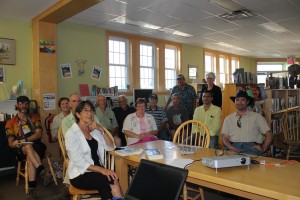Book Launch at the P-A Library: The Travel Journals of Tappan Adney
Stephanie Kelley
So who was Tappan Adney? I got the invitation to attend the book launch of the second volume of Tappan Adney’s Travel Journals at the library.

I promptly ordered a copy of Volume One through the library to learn more and quickly discovered that Edwin Tappan Adney was one of the most remarkable and extraordinary men of his era.
He was born in Ohio in 1868, and became a man of many remarkable talents, skills and interests who ultimately adopted New Brunswick as his spiritual home.
He was accepted into university at the age of 13, where he took a full load of courses in his two main interests at the time, ornithology and art.
By age 15 he was reading classic literature in the original Latin and Greek. By the time he was 18, he had completes three years of art training in New York City and in 1887 he left for a summer vacation in New Brunswick, an event that utterly changed the course of his life.
In New Brunswick, he met Native people for the first time and discovered the birch bark canoe, which became his passion.
He wrote a monumental book detailing how to build birch bark canoes, a work that is still in print and regarded as the bible on the subject.
He was a gifted artist and illustrator, who made a living by writing and illustrating articles for magazines. He supplied line drawings to illustrate The Handbook of the Birds of Eastern North America, which was published in the early 20th century.
He was a compulsive journalist and list maker, who exactingly recorded and illustrated his countless experiences and adventures.
He made his final home in a small cabin just outside of Woodstock, and upon his death in 1950 his vast treasure trove of more than 80 meticulously written and illustrated journals, among countless other papers and records, was discovered.
Goose Lane published volume one of these journals in 2010, and this year just published volume two.
Andrea Bear Nicholas wrote the preface to this volume, and came to library to explain who Adney was, and why he is such an important character in the history of our province.
There are no other records about our local region that offer as much lush and detailed descriptions of life as it really was as Adney’s journals!
These are absolutely fascinating accounts of life in the woods. Adney kept a record of everyone he met in his explorations and travels, and I saw many local names of folks that still have family in the area, including the name of my own great grandfather, John Stewart.
Adney learned the Maliseet language, and became close friends with the Maliseet community, helping them to regain or retain title to their ancestral lands. He campaigned on their behalf in many ways.
For three years, from 1888-1891, the provincial government banned big game hunting for all residents. This ban was part of a greater plan to turn the Native population from their traditional lifestyle and turn them into farmers, conveniently collected together and thus freeing up their traditional hunting grounds.
Tappan noted, “It seemed to me that the Indian had attained that which the Japanese possessed… not so much a low standard of living as a high standard of simplicity.”
Adney married Minnie Bell Sharp, a woman as remarkable and with as independent spirit as his own. She refused to pay taxes because women did not have the vote!
Adney was one of the founders of the Explorers Club in New York City. Among his many other passions and interests was heraldry. He designed and painted many designs, and submitted a design for the flag of New Brunswick that, to his regret, was not accepted.
During World War One, he saved the lives of countless soldiers with his zig zag trench design. World War One ushered in the new age of machine warfare.
Traditional trench warfare was fought from trenches dug in a straight line. When bombs fell into these straight trenches, many men died. The zig zag trench design contained the blast perimeter and destruction.
The Journals of Tappan Adney offer us an intimate and thrilling look at early hunting, fishing and exploring life in our area, and should probably be part of our school curriculum!
